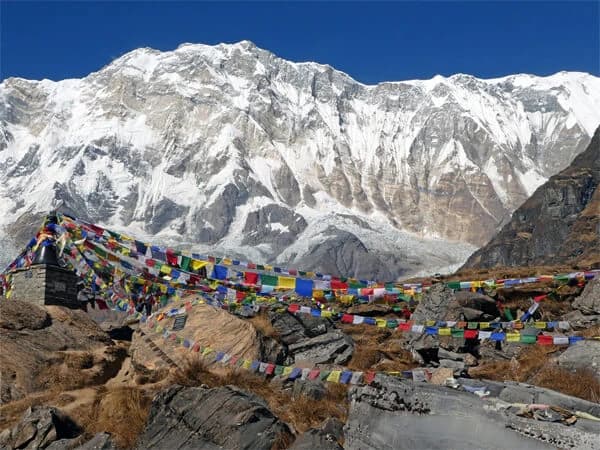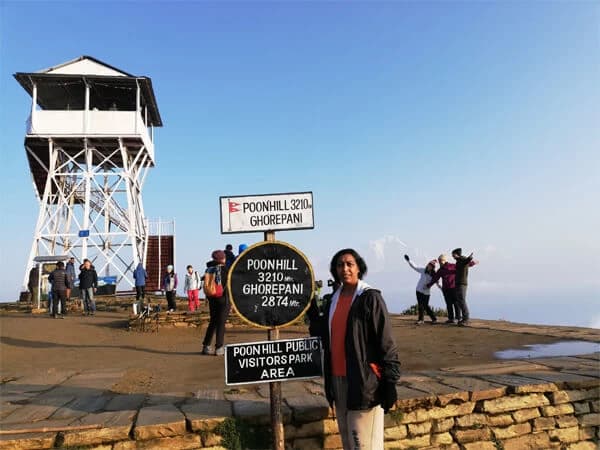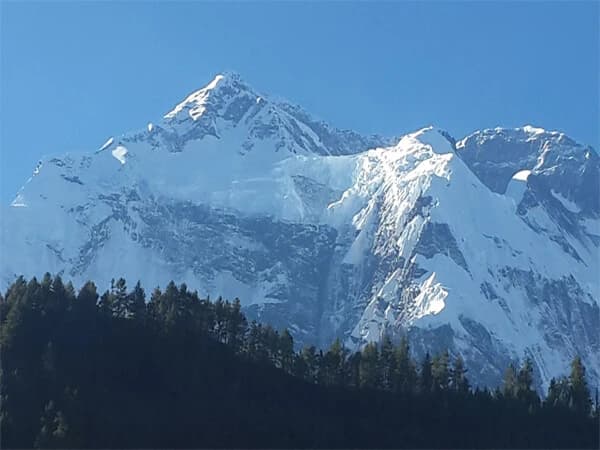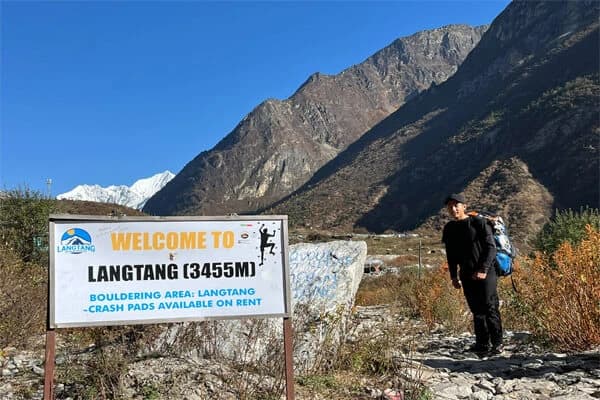The best time for Annapurna Circuit Trek is during the spring (March to May) and autumn (September to November) seasons when the weather is clear, the skies are blue, and the mountain views are at their best. These months offer ideal trekking conditions with moderate temperatures, minimal rainfall, and blooming rhododendrons or vibrant fall colors along the trail, making it the perfect time to experience the full beauty of the Annapurna region.
Best Time for Annapurna Circuit Trek
The best time for Annapurna Circuit trek is in spring and autumn, when the trails are dry, visibility is excellent, and the weather is stable for high-altitude hiking. Choosing these seasons ensures a safer and more enjoyable journey, with clear views of Annapurna, Dhaulagiri, and other Himalayan giants.
The Annapurna Circuit Trek is one of Nepal's most popular treks. The trail encircles the Annapurna massif, which includes Annapurna I, the world’s 10th-highest mountain peak. Most trekkers prefer this trek rather than the Everest Base Camp Trek and Manaslu Circuit Trek. Approximately one-third of trekkers coming to Nepal attempt the Annapurna Circuit Trek.
During the trek, you pass through amazing landscapes, serene valleys, the deepest Georges, glaciers, and Himalayan views. You will have majestic views of the Annapurna, Dhaulagiri, Tukuche, Gangapurna, etc. The trek starts from the low altitude of 1000m to the highest altitude of 5416m at Thorong La Pass. The total distance covered by the trek is 128 miles.
While trekking you will pass through the traditional villages where the local people are warm and welcoming. You will have a cultural experience with the indigenous people of this region including Gurungs, Magars, and Thakalis.
The trail goes through the Annapurna Conservation Area, Nepal's largest conservation area. This area protects wildlife and their habitats, and visitors can observe its wonderful biodiversity. It offers an adventure through diverse landscapes and cultures. Beginning in lush subtropical forests, the trail ascends to the arid, high-altitude desert near Thorong La Pass.
Along the way, you will encounter cascading waterfalls, terraced farmlands, and snow-clad peaks, including Annapurna I and Dhaulagiri. The region is rich in biodiversity, home to species like Himalayan thar and snow leopards. Villages like Manang and Marpha showcase vibrant Tibetan-influenced culture and adventure.
Importance of choosing the right time for the trek
The Annapurna Circuit trek is challenging and rewarding. Choosing the right time is crucial for the success and enjoyment of this journey.
Weather Conditions and Safety
The weather in the Himalayas is unpredictable. Each season has advantages and disadvantages. Trekking during favorable weather, such as in spring or autumn, minimizes risks related to harsh conditions. Clear skies and stable temperatures during these periods ensure safer trails and better visibility. Whereas, trekking in winter or monsoon seasons requires extra preparation to navigate snowy paths, slippery trails and potential landslides.
Trail Experience
Choosing the right time impacts your overall trekking experience. During peak seasons, the trails are bustling with trekkers, which can be both exciting and overwhelming. Off-peak seasons offer solitude but might have limited accommodations and facilities due to closures.
Scenery and Cultural Experience
The beauty of the Annapurna region is unique and different in each season. Spring is adorned with blooming rhododendrons, while autumn offers the clearest mountain vistas. Trekking during festival seasons like Dashain and Tihar adds a cultural dimension to the journey.
Best Time Based on Weather Conditions

The best times for trekking the Annapurna Circuit based on weather conditions are during spring and autumn. During these months, the weather is generally clear and stable, with mild temperatures at lower altitudes and comfortably cool conditions at higher elevations. These seasons also offer the best visibility, allowing trekkers to enjoy panoramic views of the Annapurna range and other surrounding peaks.
In contrast, summer brings the monsoon, with heavy rains and slippery trails. Winter brings cold temperatures and snow, making higher elevations more challenging to navigate. Spring and autumn offer the ideal trekking conditions.
Spring (March-May):
Spring is one of the best times to trek the Annapurna Circuit. It offers a perfect mix of favorable weather, vibrant natural beauty, and great trekking conditions. However, it is essential to know its advantages and challenges to make the most of your adventure.
Weather and Scenery in Spring
Spring in the Annapurna region offers moderate temperatures, ranging from 10°C to 20°C at lower elevations during the day. The temperatures near Thorong La Pass are colder, sometimes dipping below freezing. The weather is stable with fewer chances of rain and snowstorms.
Flora and Fauna: The trails are covered with blooming rhododendrons, magnolias, and wildflowers, creating a colorful landscape. This season also offers a chance to spot wildlife like Himalayan thar and langurs.
Views: The skies are generally clear in the mornings. You can observe the stunning vistas of peaks like Annapurna I, Dhaulagiri, and Machhapuchhre.
Pros:
- Pleasant weather: Spring provides moderate daytime temperatures and cooler but manageable conditions at higher altitudes. The weather is mild and consistent, ideal for trekking. This makes trekking more comfortable during long hiking days. The stable weather reduces the risks associated with sudden storms.
- Blooming rhododendrons: The trails become alive with colorful rhododendrons in full bloom, particularly in forests at lower altitudes. This vibrant scenery provides a great trekking experience.
- Clear Mountain views: With the skies clearing up, the views of peaks like Annapurna, Dhaulagiri, and Machhapuchhre are stunning. Mornings offer beautiful vistas ideal for photography.
- Longer days: Spring days are longer, providing plenty of daylight for trekking. This allows for more relaxed trekking schedules and time to enjoy the surroundings.
- Festive Atmosphere: The Nepali New Year often coincides with this trekking season. This is a great opportunity to experience local culture and traditions. Festivals like Holi and Buddha Jayanti allow trekkers to experience local celebrations in villages along the route.
- Well-prepared Trails: As the trekking season kicks off in spring, the teahouses are fully operational and stocked with supplies. Trails are clear of snow in lower regions. This makes it easier to navigate.
Cons:
Potential for snowfall: While the weather is generally stable, high-altitude areas like Thorong La Pass might have late-season snowfall. It can occasionally disrupt plans or require extra caution.
- Higher prices: The cost of accommodation, meals, and trekking services may rise due to increased demand. Guides and porters can also be in short supply.
- Crowded Trails: Spring is a peak trekking season. The trails, teahouses, and viewpoints can become crowded. Advanced bookings are recommended.
- Allergies and Insects: The blooming flora can trigger allergies for some trekkers. Additionally, lower altitudes may have an increase in insects like mosquitoes or leeches in wetter areas.
- Variable weather at higher elevations: While spring is generally stable, high-altitude areas like Thorong La Pass can still experience sudden snowstorms or freezing conditions.
- Altitude risk: As with any high-altitude trek, there is a risk of Altitude sickness (AMS) in the Annapurna Circuit trek. Even in favorable weather, acclimatization is crucial for successfully crossing high points like Thorong La Pass.
Trekking the Annapurna Circuit in spring is a delightful experience. It offers a blend of natural beauty and pleasant conditions. With proper preparation for crowds and occasional snow, you can have unforgettable memories.
Autumn (September-November):
Autumn is the most popular season for trekking the Annapurna Circuit. It offers perfect weather conditions, stunning mountain vistas, and a vibrant cultural atmosphere. This season offers an exceptional trekking experience. However, this season comes with its own set of challenges.
Weather and Scenery in Autumn
Autumn in the Annapurna region offers perfect trekking conditions. Temperatures range from 10°C to 20°C during the day at lower altitudes, with cooler temperatures at night. At higher elevations, temperatures can drop below freezing, especially near Thorong La Pass.
Clear Skies: The monsoon rains leave the skies crystal clear, providing stunning views of peaks like Annapurna I, Dhaulagiri, and Machhapuchhre.
Landscape: The trails are surrounded by lush greenery after the monsoon. The terraced fields are golden and forests change into the hues of autumn.
Pros:
- Stable weather: Autumn is ideal for trekking due to clear and crisp days with stable temperatures. It is perfect for long treks. Daytime temperatures are mild, while nights are cooler but manageable with proper gear. The comfortable conditions make walking enjoyable. The weather is predictable with less risk of disruption.
- Mountain Views: Post-monsoon skies are clear and offer stunning views of snow-capped peaks such as Annapurna, Dhaulagiri, Manaslu, etc. The mornings are great for breathtaking panoramic views of the Himalayas.
- Vibrant fall colors: The landscape transforms with golden-hued fields and forests. This fall color creates a picturesque setting. The traditional harvest activities in local villages add cultural richness to the trek.
- Cultural immersion: The season coincides with major festivals like Dashain and Tihar. Trekking during these times provides opportunities to observe and participate in Nepali traditions.
- Longer Trekking Days: With dry weather and extended daylight hours, you can cover more ground each day. You will not have to worry about rain or poor visibility.
- Well-maintained Trails: The monsoon rain clears the trails. It is less dusty and more pleasant to hike. Teahouses are fully operational and well-stocked. They offer better service. Guides and porters are more readily available during this season.
- Comfortable trekking experience: Autumn’s predictable weather reduces uncertainties. It is an excellent time for comfortable trekking.
Cons:
- Crowded trails: Being one of the popular seasons, the trails, teahouses, and viewpoints are bustling with trekkers. Popular villages like Manang, Thorong Phedi and Muktinath often see a high number of trekkers. This can limit opportunities for solitude.
- Competition for Accommodation: Many trekkers fill up the teahouses quickly in smaller villages. You may need to book accommodations in advance or share dormitory rooms during peak periods.
- Higher prices: The popularity of autumn trekking raises the prices of lodging, guides, and porters. Bargaining opportunities are also limited.
- Colder Nights: While daytime temperatures are pleasant, nights at higher altitudes can drop below freezing. Proper gear is required to stay warm and safe.
- Altitude sickness risk: The risk of altitude sickness (AMS) remains high due to the altitude gain on the circuit. Trekkers must acclimatize properly and be cautious of overexertion.
- Limited availability of Guides and Porters: Due to high demand, securing experienced guides and porters can be challenging without prior booking.
- Busy Transport and Logistics: The popularity of autumn trekking can make transportation to and from Besisahar or Pokhara more challenging. Buses and jeeps often fill up quickly, requiring reservations.
Trekking the Annapurna Circuit in autumn is a visually and culturally enriching experience. The stable weather and breathtaking scenery make it worth the crowds and higher expenses. Autumn is a great choice for those who prioritize stunning views and comfortable trekking conditions.
Winter (December-February):
Winter offers a unique experience for trekkers on the Annapurna Circuit. This season comes with challenges as well as rewards. The tranquil trails and breathtaking snowy vistas are good aspects of trekking in winter. Understanding the advantages and drawbacks of trekking the Annapurna Circuit in winter can help trekkers prepare for a safe and rewarding journey.
Weather and Scenery in Winter
Winter in the Annapurna region is characterized by cold temperatures and stunning landscapes. Daytime temperatures at lower altitudes range from 5°C to 12°C. The higher elevations near Thorong La Pass have temperatures as low as -20°C.
- Snow-Covered Peaks and Trails: The snow adds a magical touch to the Himalayas. It creates breathtaking views of Annapurna I, Dhaulagiri, and Machhapuchhre.
- Clear skies: Winter often brings crisp, clear skies in the mornings. It is one of the best times for unobstructed mountain views.
Pros:
- Fewer crowds: Winter is the off-season for trekking. It is ideal for those seeking solitude. You can enjoy peaceful trails, quieter teahouses, and undisturbed views of the Himalayas. You do not need to compete with a large group of trekkers.
- Peaceful atmosphere: The peaceful environment of this season enhances the overall trekking experience. The snow-covered landscapes are quiet and still. The absence of a bustling crowd creates a tranquil escape into nature.
- Mountain Views: The cold, dry air in winter has some of the clearest mountain vistas. Popular viewpoints like Thorong La Pass and Poon Hill offer panoramic views of snow-covered peaks.
- Snow-covered landscapes: During winter, the Annapurna region transforms into a winter wonderland. The trails, forests, and mountains are blanketed in snow. The beauty of the Himalayas under clear skies is great for photography.
- Authentic Local Interaction: With fewer trekkers, interactions with locals become more personal and authentic. You will have opportunities to learn about their way of life in a relaxed environment.
- Cultural Immersion: Winter coincides with festivals like Maghe Sankranti. You will have cultural insights into local traditions and customs while celebrating these festivals.
- Discounted Rates: Winter is off-season. Teahouses often offer lower rates for rooms and food. This makes it a more budget-friendly option for those willing to brave the cold.
- Adventure and Challenge: Winter is for those seeking a unique trekking experience. The snowy trails and colder conditions add an adventure to the journey.
Cons:
- Harsh weather: Temperatures can be harsh at night in higher altitudes. Extreme cold requires thermal clothing. Trekking through snow-covered trails needs extra physical preparation and gear like crampons.
- Limited accommodations: Many teahouses at higher altitudes close for winter. This may reduce your options for accommodations. It requires careful planning to ensure access to food and shelter along the route.
- Snow and Trail blockages: Snowfall can make trails slippery and difficult to navigate at higher elevations. The Thorong La Pass is often closed during heavy snow. It requires flexible planning or alternative routes.
- Shorter Days: With limited daylight hours, trekkers must plan their schedules carefully to avoid being on the trail in the dark.
- Altitude Challenges: The cold weather increases the risk of altitude sickness as the body tries to acclimatize. Slow and steady trekking along with proper acclimatization days is essential.
- Limited Accessibility: Transportation to and from trailheads like Besisahar or Jomsom may be affected by snow. There may be delays or complications.
Trekking the Annapurna Circuit in winter is a rewarding challenge for prepared trekkers. The peaceful atmosphere and snowy landscapes offer a unique experience. With proper gear, planning, and a flexible itinerary, winter trekking can be a magical experience.
Summer (June-August):
Summer coincides with the monsoon season in Nepal. It is a less popular time for trekking the Annapurna Circuit. Trekkers can choose alternative treks in rain-shadow areas like Upper Dolpo. The rainy season presents challenges as well as rewards for those willing to embrace its conditions. This season demands careful planning and preparation for a safe and enjoyable journey.
Weather and Scenery in Summer
Summer weather in the Annapurna region comes with warm temperatures and heavy rainfall.
Temperature:
At lower altitudes, daytime temperatures range from 15°C to 30°C, with cooler nights. At higher elevations, the temperatures drop, ranging from 5°C to 15°C during the day. It can be freezing at night.
Rainfall:
Monsoon rains are frequent and can occur daily in the lower and mi-altitude regions. The upper Mustang area, which lies in the rain shadow of the Himalayas, experiences less rainfall.
Lush Scenery:
The rains rejuvenate the landscape. The valleys turn into vibrant green with blooming wildflowers and waterfalls cascading from the mountains.
Pros:
- Lush greenery: The monsoon rains rejuvenate the Annapurna region. The hills, valleys, and forests burst with life, creating vibrant landscapes. The lower altitudes are beautiful with terraced rice fields and blooming wild flowers. The picturesque scenery is great during summer.
- Fewer crowds: Summer is the off-season for trekking. The trails and teahouses are less crowded. This allows trekkers to enjoy a more quiet and personal space. They will have plenty of opportunities to connect with nature and local communities.
- Cultural Immersion: With fewer trekkers around, summer provides more interaction with local villages. You can engage deeply with the culture and lifestyle of the indigenous communities including Gurung, Thakali, etc.
- Budget-Friendly: With lower demand, accommodations and meals at teahouses are often more affordable. Guides and porters are more available and may offer discounted rates.
- Unique Mountain Views: The morning views can be clear before the clouds roll in. The occasional glimpses of mist-covered peaks and skies create a unique view. Photographers often appreciate the unique beauty of the monsoon season.
- Rain Shadow Areas: Regions like Manang and Upper Mustang lie in the rain shadow. There is minimal rain in this region which makes them great alternatives for trekking during summer.
Cons:
- Monsoon rains: Daily rains often heavy in the afternoon and evening can make the trekking challenging. Wet trails become slippery and muddy, requiring extra care and sturdy footwear. It may be difficult to stay dry and manage damp gear. You may need waterproof gear including a poncho, a rain cover for your backpack, etc.
- Landslides and Trail Blockages: The monsoon increases the risk of landslides on steep or unstable sections of the trail. These can cause delays. Rivers may swell, making some crossings difficult. This forces trekkers to reroute their plans.
- Leeches and Bugs: The humid conditions increase the presence of leeches, mosquitoes, and other insects at lower altitudes. It is essential to wear long clothing and use insect repellent.
- Humidity and Heat: Lower elevations can feel hot and humid. It can make trekking uncomfortable until higher, cooler altitudes are reached.
- Obstructed Views: Cloud cover and mist are common during summer. This can limit the visibility of the Himalayan Peaks. This can reduce the appeal of certain viewpoints.
- Difficulty in Navigation: Trails can be harder to follow due to overgrowth of vegetation and poor visibility. Hiring a guide becomes essential in such conditions.
- Limited Accessibility: Transportation to and from the trailheads may be disrupted due to roadblocks caused by landslides or flooding. This may require flexibility in the itinerary.
Trekking the Annapurna Circuit in summer is a refreshing experience for those prepared for its challenges. The lush landscapes and quieter trails are ideal for adventurers looking for solitude and greenery. However, the rains, bugs, and occasional landslides require flexibility, careful planning, and proper gear. By adapting to the season’s challenges, you will immerse yourself in the dynamic environment of the Annapurna Circuit.
With the support of experienced guides, like those from Nepal Trekking routes, any season can be a memorable adventure.
Factors to Consider Beyond Weather
When planning a trek, the weather is often a major focus. However, other factors like festivals, crow levels, acclimatization needs, and permits also play crucial roles. These considerations can significantly influence your trekking experience. These can affect cultural encounters, logistics, and overall safety. Below is a detailed breakdown of these factors to help you prepare for a rewarding adventure.
Festivals and Events:
Nepal’s rich cultural heritage is reflected in its various festivals and events. They coincide with the trekking seasons. Participating in or planning your trek around these festivals can offer an amazing cultural experience.
Festivals during Spring:
- Holi (March): Holi is known as the festival of colors. It is celebrated with vibrant colors and joy. While trekking. You might encounter villages celebrating the festivities.
- Buddha Jayanti (April/May): This marks the birthday of Buddha. Trekking in regions with Buddhist communities, such as Langtang or Upper Mustang, provides a chance to observe special ceremonies.
Festivals during Autumn:
- Dashain (October): Dashain is Nepal’s biggest festival. It is celebrated with family gatherings and traditional rituals. In villages along the trail, you can witness locals honoring their traditions.
- Tihar (November): Tihar is the festival of lights. The houses lip up with lights and colorful decorations. Trekking through villages during Tihar offers unique cultural insights.
Festivals during Monsoon and Winter:
- Janai Purnima (August): This festival involves sacred thread-wearing ceremonies.
- Maghe Sankranti (January): It is a mid-winter festival celebrated with traditional foods like yams and ghee.
Why consider festivals in Trekking Plans?
- Immersive cultural Experience: Participating in these festivals provides a glimpse into local authentic lifestyles.
- Unique opportunities: Festivals like Mani Rimdu in the Everest region combine trekking with witnessing sacred Buddhist dances.
- Potential Challenges: Festivals can make certain routes busier and accommodations may be in higher demand.
Crowds:
The number of trekkers on Nepal’s trails varies greatly depending on season. Your trekking experience will be affected in terms of solitude, availability of accommodations, and overall enjoyment.
Peak season (Spring and Autumn) vs. Off-peak season (Winter and Summer)
Peak season Crowds (Spring and Autumn):

Spring and autumn are the most popular times to trek. Favorable weather clear skies, and vibrant landscapes attract large numbers of trekkers.
Popular trails like the Everest Base Camp, Annapurna Circuit, and Langtang Valley can become crowded at teahouses and popular viewpoints.
Advantages of Trekking during Peak seasons:
- Optimal weather conditions for trekking.
- Higher chances of meeting fellow trekkers to have a social experience.
- Fully operational teahouses and better food variety.
- Drawbacks of Peak season crowds
- Teahouses may fill up quickly which requires pre-booking.
- Trails can feel busy reducing the sense of solitude.
Off-Peak Season Crowds (Summer and Winter):
During summer/monsoon and winter, the number of trekkers decreases significantly.
Certain routes like the Upper Mustang (rain shadow region) or Poon Hill (short trek) remain accessible with manageable conditions.
Advantages of Off-Peak season trekking:
- Solitude on the trails and quieter teahouses.
- Opportunity for discounted rates on accommodation and guides.
- Unique landscapes like lush monsoon greenery or serene winter snowfields.
Challenges of Off-Peak seasons:
Limited availability of open teahouses in remote areas.
Increased difficulty navigating due to rain, snow, or shorter daylight hours.
Acclimatization:
Acclimatization is an important consideration for trekking in Nepal if you are trekking to high-altitude regions such as the Annapurna or Everest Base Camp. Proper acclimatization minimizes the risk of altitude sickness. It will ensure a safer and more enjoyable trek.
Understanding Acclimatization:
Acclimatization is a process that allows your body to adjust gradually to the decreasing oxygen levels at higher altitudes.
Acute mountain sickness (AMS) symptoms include headaches, nausea, dizziness and shortness of breath. If untreated, AMS can progress to more severe conditions like HAPE(High-Altitude Pulmonary Edema) or HACE(High-Altitude Cerebral Edema).
Key Acclimatization points:
Treks often include built-in acclimatization days. They are allocated at mid-altitude stops like Namche Bazaar on the Everest trek or Manang on the Annapurna Circuit trek.
Acclimatization days involve light hiking or rest to allow your body to adjust.
Best Practices for Acclimatization:
Follow the golden rule: Climb high, sleep low. Ascend to a higher altitude during the day and descend to sleep at a lower altitude.
Stay hydrated and avoid alcohol. Alcohol can dehydrate the body and worsen AMS symptoms.
Ascend gradually, limiting the altitude gain to 300-500 meters per day above 3,000 meters.
Preventive Medications:
Consult a doctor about taking medication to prevent AMS.
Emergency Protocols:
If AMS symptoms persist after rest and descent, then seek medical help immediately.
Most trails have access to helicopter rescue, but insurance is essential to cover these costs.
Permits and Restrictions:
Availability of permits during different seasons
Securing trekking permits in Nepal is a straightforward process. The availability and ease of getting a permit may vary by season due to fluctuations in trekking demand and government policies. Understanding this can help you plan efficiently and avoid unnecessary delays.
Peak Seasons (Spring and Autumn)
Demand: Spring and autumn are the busiest trekking seasons, attracting thousands of trekkers. The demand for permits is high.
Availability: Permits for popular regions like the Annapurna Circuit, Everest Base Camp, and Langtang Valley are readily available from government offices in Kathmandu or Pokhara. However, the offices may experience longer processing times due to increased traffic.
Advice: Arrive early at permit offices to avoid long queues, or work with Nepal Trekking Routes, a trekking agency to handle the process for you.
Off-Peak Seasons (Summer and Winter)
Demand: During the monsoon and winter, the number of trekkers drops significantly. There will be less crowds at permit offices.
Availability: Permits remain available year-round. Restricted areas like Upper Mustang or Manaslu may have challenges such as closures due to bad weather or transportation delays to remote areas.
Advice: Double-check the operating hours of permit offices during public holidays or adverse weather conditions.
Conclusion
The Annapurna Circuit trek offers a unique experience in every season. From lush green valleys to high-altitude terrains, the trek offers a thrilling adventure for both seasoned and beginner trekkers. Choosing the right time to trek is essential for a rewarding experience. Spring and autumn are ideal for clear skies, pleasant weather, and vibrant landscapes. Winter provides solitude and stunning snow-covered views. Summer, despite monsoon challenges, provides lush greenery.
Choose your ideal trekking time based on individual preferences and priorities. With proper preparation and careful planning, you will have the fascinating adventure of a lifetime.


.webp&w=1200&q=75&dpl=dpl_4U3CaZUV3Y5iKdBNPJmVMATJy3AB)






